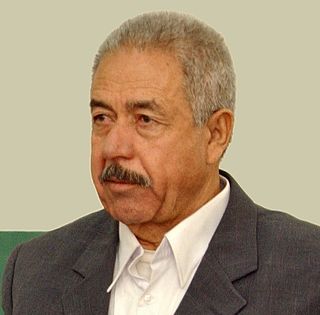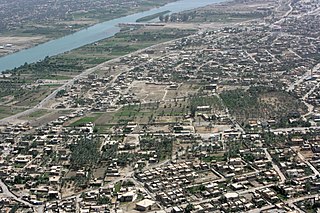
Samawah or As-Samawah is a city in Iraq, 280 kilometres (174 mi) southeast of Baghdad.

Ali Hassan Majid al-Tikriti, nicknamed Chemical Ali, was an Iraqi military officer and politician under Saddam Hussein who served as defence minister, interior minister, and chief of the Iraqi Intelligence Service. He was also the governor of Kuwait during much of the 1990–91 Gulf War.

Ramadi is a city in central Iraq, about 110 kilometers (68 mi) west of Baghdad and 50 kilometers (31 mi) west of Fallujah. It is the capital and largest city of Al Anbar Governorate which touches on Syria, Jordan and Saudi Arabia. The city extends along the Euphrates which bisects Al Anbar. Founded by the Ottoman Empire in 1879, by 2018 it had about 223,500 residents, near all of whom Sunni Arabs from the Dulaim tribal confederation. It lies in the Sunni Triangle of western Iraq.

The Kingdom of Iraq under British Administration, or Mandatory Iraq, was created in 1921, following the 1920 Iraqi Revolution against the proposed British Mandate of Mesopotamia, and enacted via the 1922 Anglo-Iraqi Treaty and a 1924 undertaking by the United Kingdom to the League of Nations to fulfil the role as Mandatory Power.

Deir ez-Zor is the largest city in eastern Syria and the seventh largest in the country. Located on the banks of the Euphrates River 450 km (280 mi) to the northeast of the capital Damascus, Deir ez-Zor is the capital of the Deir ez-Zor Governorate. In the 2018 census, it had a population of 271,800.

The tribe of Shammar is a tribal Arab Qahtanite confederation, descended from the Tayy, which migrated into the northern Arabian Peninsula from Yemen in the second century. It is the largest branch of the Tayy, and one of the largest and most influential Arab tribes. The historical and traditional seat of the tribe's leadership is in the city of Ḥaʼil in what was the Emirate of Jabal Shammar in what is now Saudi Arabia. In its "golden age", around 1850, the Shammar ruled much of central and northern Arabia from Riyadh to the frontiers of Syria and the vast area of Upper Mesopotamia.

The 1991 Iraqi uprisings were ethnic and religious uprisings against Saddam Hussein's regime in Iraq that were led by Shi'ites and Kurds. The uprisings lasted from March to April 1991 after a ceasefire following the end of the Gulf War. The mostly uncoordinated insurgency was fueled by the perception that Iraqi President Saddam Hussein had become vulnerable to regime change. This perception of weakness was largely the result of the outcome of the Iran–Iraq War and the Gulf War, both of which occurred within a single decade and devastated the population and economy of Iraq.
Dulaim or Dulaimi or Al Duliam or Dulaym is an Arab royal tribe, with over seven million members. The tribe's history goes back to pre-Islamic times and members reside today in Iraq and neighboring countries such as Syria, Kuwait and Jordan.
The Bani Utbah is an Arab tribal confederation in the Arabian Peninsula. The confederation is thought to have been formed when a group of clans from Najd migrated to Eastern Arabia in the late 17th century and early 18th century. Most of the Utub clans and families, such as the Al-Sabah and Al-Khalifa, trace their lineage back to Anizah tribe, with the exception of some, such as the Al Bin Ali, whose lineage goes back to the Banu Sulaym tribe. The Al Bin Ali along with the current ruling families of Bahrain and Kuwait were the rulers of the federation. The name of the confederation is found in the form Attoobee or Uttoobee in English sources up to the late 19th century.

Shia Islam in Iraq has a history going back to the times of Ali ibn Abi Talib, the first imam of Shia Islam and fourth caliph of Sunni Islam who moved the capital of the early caliphate from Medina to Kufa two decades after the death of Muhammad. Today, Shia Muslims make up around 55% of the Iraqi population. Iraq is the location of the holy cities of Najaf and Karbala, pilgrimage sites for millions of Shia Muslims.
Suq Al-Shuyukh District is a district of the Dhi Qar Governorate, Iraq. Suq al-Shuyukh is a small town surrounded by date palm orchards and located on the right bank of the Euphrates, at the western end of the Hawr al-Hammar lake and wetlands, about 40 km southeast of Nasiriya. Suq al-Shuyukh is a center of date and rice cultivation, which takes place in the areas to the north and west of the lake.

Al-Hindiya District is a district of the Karbala Governorate, Iraq. Its largest town is Al-Hindiya, to the east of Karbala. The Hindiya Barrage in the north of the district controls floods and diverts water from the Euphrates into irrigation canals on both sides of the river. The district has been the scene of clashes with Turkish and British colonial forces, and more recently with American troops in 2003. The population is about 230,000, mostly Shia, including significant numbers of refugees. Infrastructure is poor, but efforts are being made to improve it.
The 1935 Rumaytha and Diwaniyya revolt or the 1935–1936 Iraqi Shia revolts consisted of a series of Shia tribal uprisings in the mid-Euphrates region against the Sunni dominated authority of the Kingdom of Iraq. In each revolt, the response of the Iraqi government was to use military force to crush the rebellions with little mercy. The administrative task of this forceful disciplining of the Shi'a tribes fell to General Bakr Sidqi

Nasiriyah is a city in Iraq. It is on the lower Euphrates, about 360 km south-southeast of Baghdad, near the ruins of the ancient city of Ur. It is the capital of the Dhi Qar Governorate. Its population in 2018 was about 558,000, making it the tenth-largest city in Iraq. It had a diverse population of Muslims, Mandaeans and Jews in the early 20th century; today its inhabitants are predominantly Shia Muslims.
Banu Asad is an Arab tribe, descended from Asad ibn Khuzayma. They are Adnanite Arabs, powerful and one of the most famous and influential tribes. They are widely respected by many Arab tribes, respected by Shia Muslims because they have buried the body of Husayn ibn Ali, his family and companions with the help of Ali ibn Husayn Zayn al-Abidin, the son of Husayn, and many martyrs from the Battle of Karbala are from the tribe. Today, many members of the tribe live in the Iraqi cities of Basra, Najaf, Kufa, Karbala, Nasiriyah, Amarah, Kut, Hillah, Diyala and Baghdad. There is a branch from the Banu Assad in Northern Sudan called Banu Kahil who have migrated from the Hijaz to Sudan. There are also members of Bani Assad tribe in Ahvaz in the Khuzestan of Iran located with neighboring tribes of Banu Tamim, Bani Malik, Banu Kaab and other notable Arab tribes.
Al-Rumaitha City is a city in Muthanna Governorate, Iraq. It is the capital of Al-Rumaitha District. Its population in 2014 was 115,431. The economy is predominantly agricultural, specializing in the production of date palms and grains.
Al-Khodar or Al-Khiḍr is a city in Muthanna Governorate, southern Iraq, located next to the Euphrates river. The city is named after the shrine of al-Khidr which is located there. As of 2018, it has 42,800 inhabitants.

The siege of Najaf was an engagement between the British Army and Iraqi rebels in the city of Najaf during the First World War. The city had fallen under the control of four sheikhs in 1915 after an anti-Ottoman uprising, and was put under British control in 1917. In 1918, as it became clear that the British were aiming to occupy rather than liberate Iraq, an anti-British movement named Jam'iya al-Nahda al-Islamiya was formed in Najaf to oppose British rule. The uprising began on 19 March when a British officer, William M. Marshall was murdered in the citadel of Najaf. The British subsequently laid siege to the city on 23 March, cutting all supply routes to the city before it ultimately surrendered on 4 May 1918. Rebel leaders were sentenced to death on 25 May. The siege is often seen as a precursor to the 1920 Iraqi Revolt. The extent of the rebellion's impact on the development of Iraqi nationalism is disputed.
Harakat Ahrar al-Iraq was formed under the name of Quwat Ahrar al-Iraq on 14 June 2014 according to the fatwa of the Grand Mufti Sheikh Mahdi Al-Sumaidaie, the grand mufti of the Republic of Iraq on the necessity of enlisting and defending Iraq.











